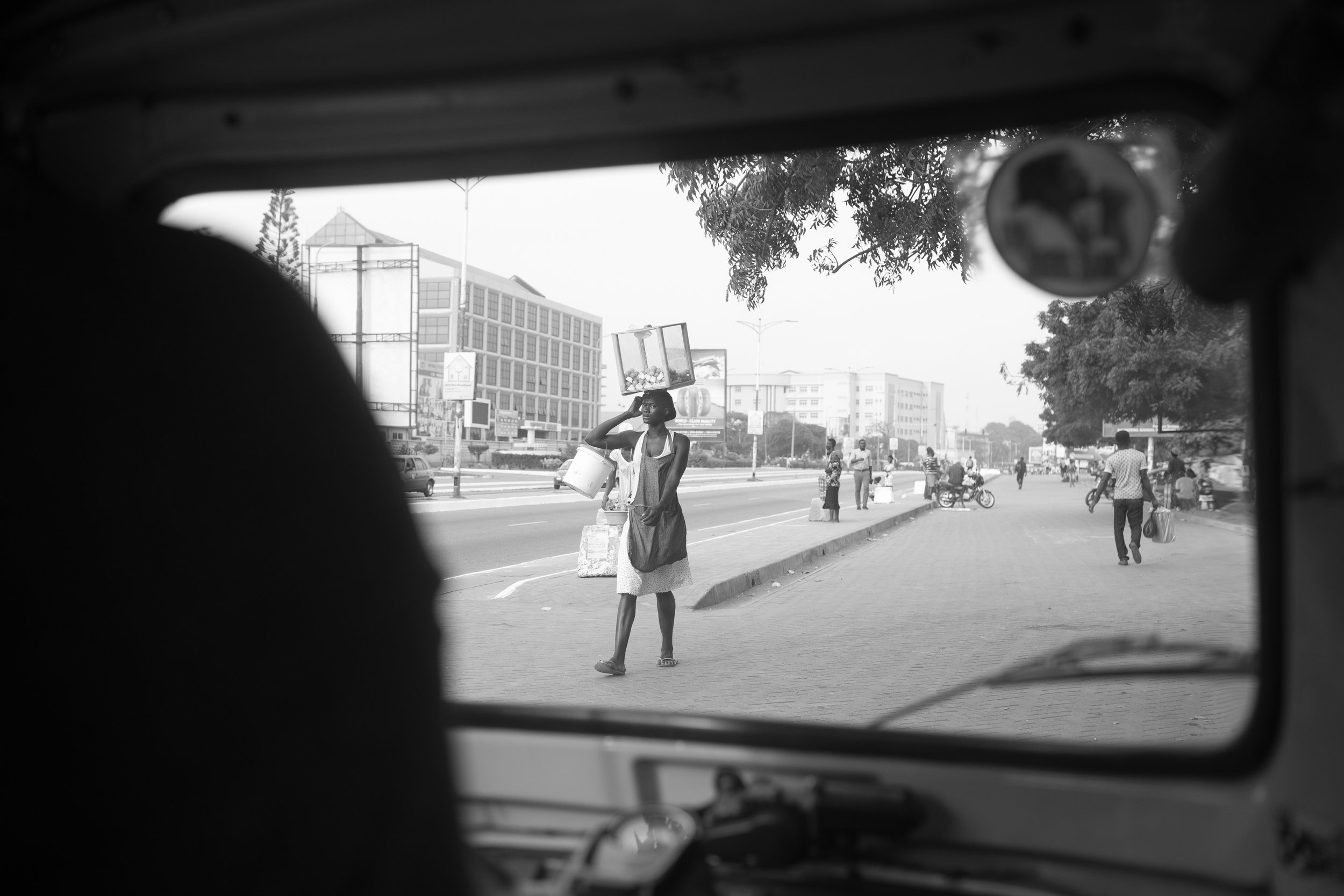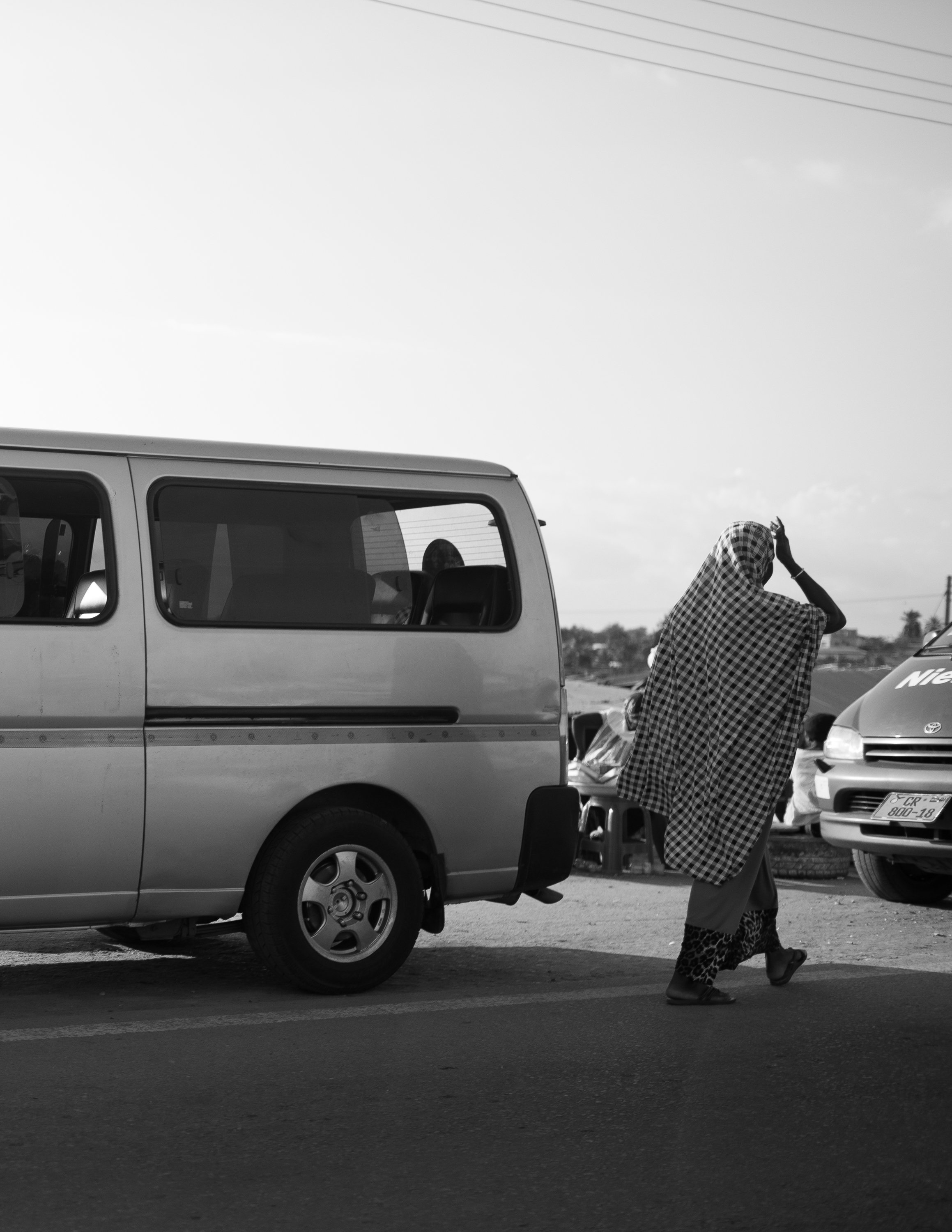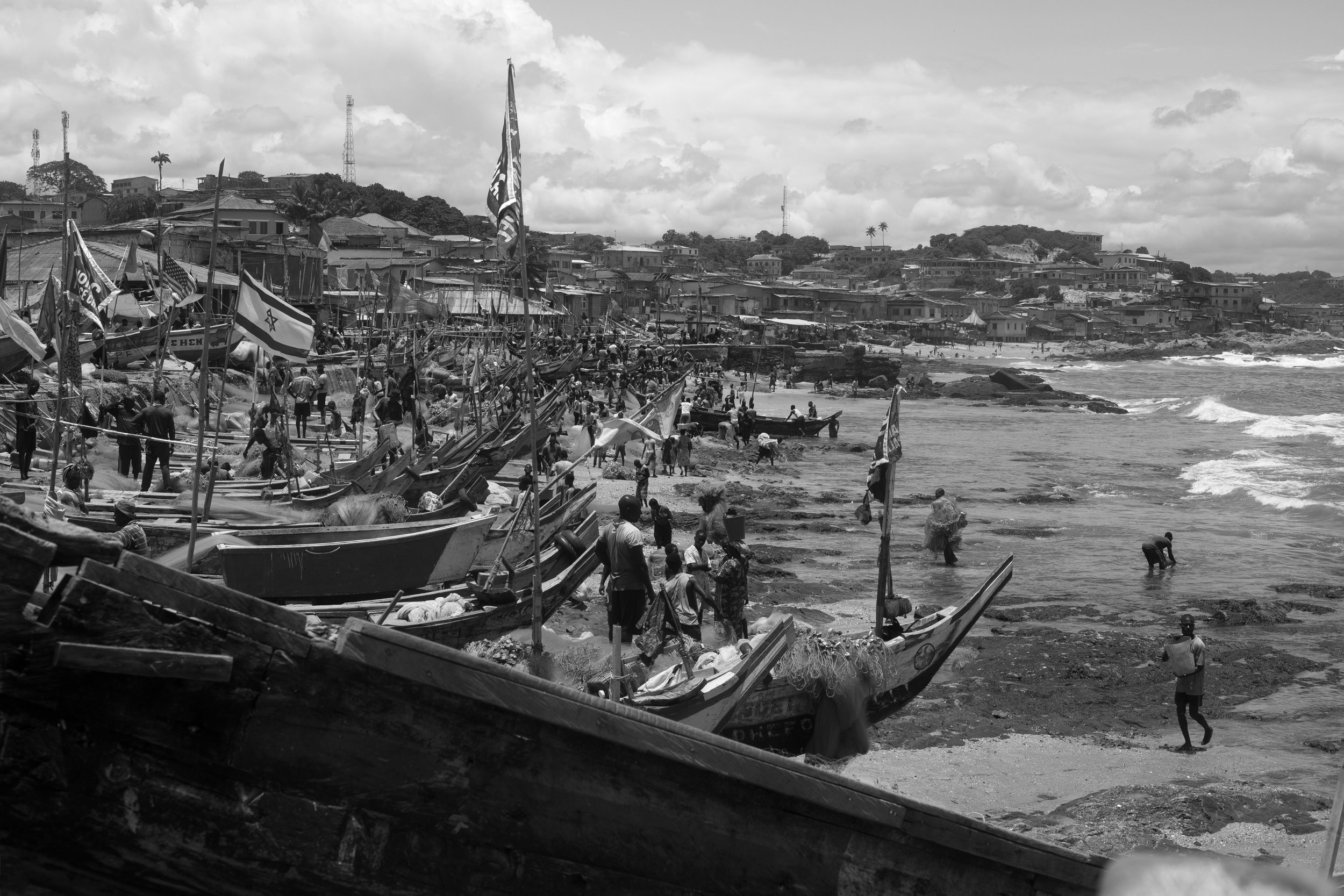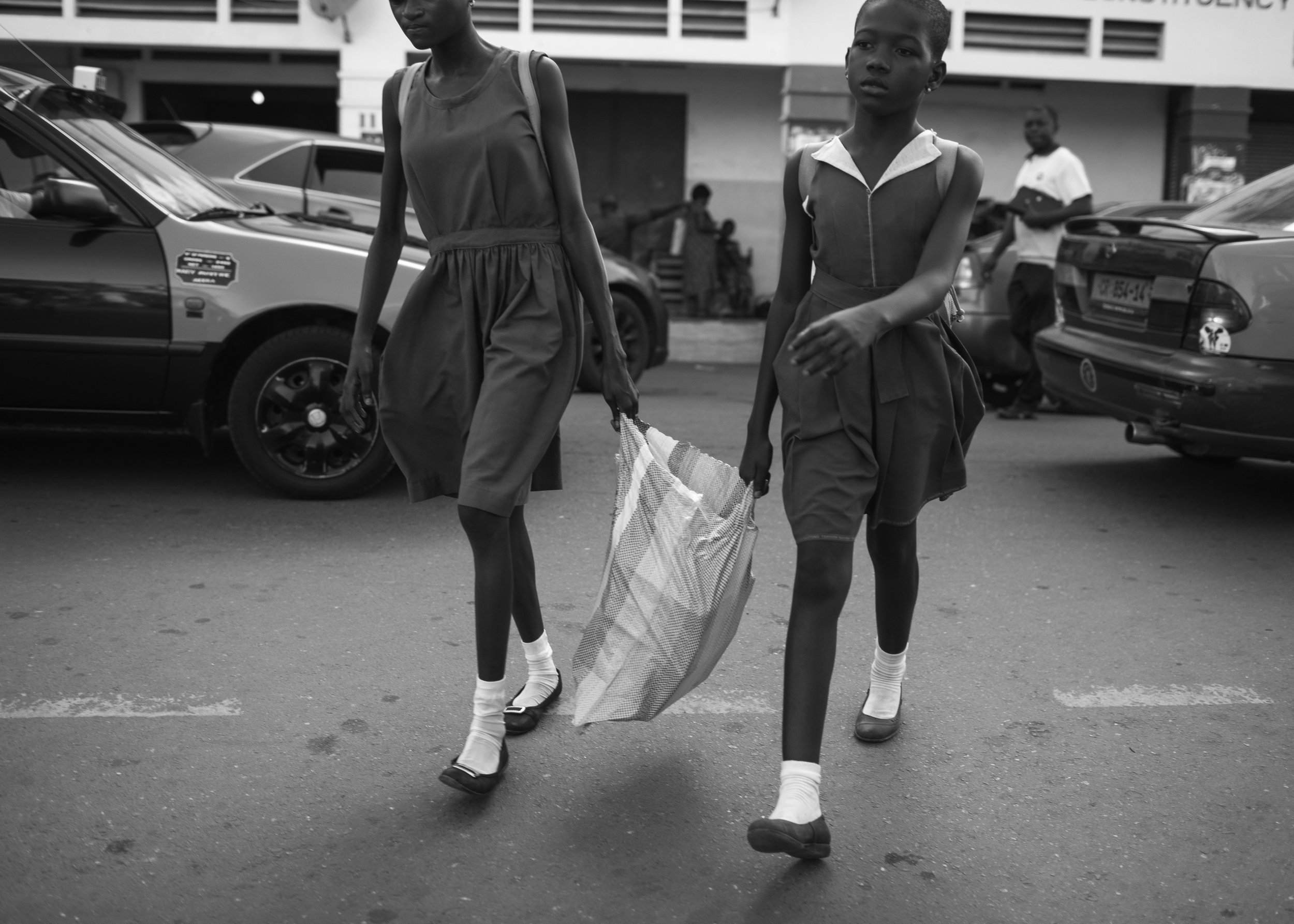On The Road with Reuben Fakoya-Brooks
Photographer, podcast host, founder and chair of the BAME Ecological Network and, as of a few weeks ago, PhD student, Reuben Fakoya-Brooks does it all. His passion for science and photography have naturally lent themselves to his growing multihypened career, allowing him to stretch both his scientific and creative talents; often simultaneously. Going from street, to club, to documentary photography with ease, his latest exhibition, ‘On The Road, Chapter 2: Accra’ is an intimate snapshot of human behaviour in Ghana.
Why did you decide to call the series ‘On The Road’?
I was travelling in Lagos and was stuck in traffic the whole time. I was actually frustrated that I couldn't do the project that I’d initially planned with my Grand Uncle and Grand Aunt. They’d been in an interracial relationship since the 1950s (she’s Norwegian) and I wanted to document that. I was with them for a lot of the time but when you’re in a car, you capture the same thing over and over again. So I steered my camera out of the window out of boredom and realised, ‘wow, there are a lot of beautiful narratives and stories out there.’
It feels like when anyone is in the car, they’re looking, but with you, as photographer, you really see people.
100% and that acts as a shield because most of the time the subjects aren’t aware that i’m taking the photograph. When a camera is in front of you your behaviour changes, you can’t be as authentic.
Your work has always felt intimately connected to the subject almost as if you’re a welcome voyeur into these strangers' lives. There’s a respectful distance that translates to deep intimacy rather than intrusion. How do you go about shooting them?
Street photography has made me very good at covertly taking photographs without intruding on someone’s space. Even my experience in event photography, especially weddings, has helped me shoot people without my presence manipulating the image.
It feels very respectful.
If you’re a very good street photographer, you do shoot in a way that is respectful. And if it is a portrait, I can still curate it. A lot of the portrait shots look like they’re posed but it's about being patient enough to get in the right position.
From the car?
From the car. There’s a lot of discipline in it and a lot of the time, you just don’t get the shot. Either the person doesn’t look at you or is too close or the shot isn’t as perfect as it could be but sometimes you get lucky.
Does that make it more exciting?
Yes because you almost have to predict where they’re going to be in a space. A lot of the time I’m adjusting the settings before the subject is even in frame, thinking, ‘okay, they might be here’ or ‘they’re going to look in this direction’ and then capturing that. In ‘On The Road’ in Lagos, there’s a photograph of a woman outside one of the transport buses that goes to Victoria Island and she looks directly at me. Not on purpose, she's looking in that direction anyway but the car is moving at an incredibly fast speed and predicting that she’s going to be looking at the camera, in that second and snapping is the skill.
That’s so cool because it’s almost like a collaborative experience between you and the subject but they don’t know. To me, that’s mad because you’re kind of setting it up and they naturally do their own thing and then you take the shot which is probably why it seems so intimate because there is an intimacy on some strange level.
You put this exhibition on yourself and fully funded it - why?
R: I realised very early on as a photographer that there's this self imposed rule that you can only exhibit your work when a gallery approaches you and that always comes with caveats. It also comes down to commission because you may not think that 15 -30% commission is a lot, but it adds up when you have lots of pieces of work. Financially, it made a lot more sense to just pay a one off fee for an exhibition space instead. Yeah, you need to put more time and effort into promoting it because you don’t have the clout of say, the V&A, but you do have more freedom. I wanted to change the idea of waiting to be approached because there are a lot of accomplished photographers out there who have never had their work in print. Even people who have won awards, it’s all digital or exhibited alongside other people’s work and it quietens your voice.
It’s so easy once you decide to do it.
R: And why wait for that validation from someone else? A lot of the time that validation comes after anyway. I’ve had a lot of people offer sponsorship and funding opportunities after my first exhibition which was very much ‘fake it ‘til you make it'.’. It was the first documentary photography project that I wanted people to see and to see me as that type of photographer where I was expressing myself in a particular way. I didn’t want to wait around to win a photography competition and even if I did it wouldn’t guarantee that my work would be shown anywhere. I wanted people to see all my images of a set narrative and pretend I was someone like Don McCullin or Steve McCurry. At the time no one knew I was doing that type of photography aside from my closest friends and I wanted to change that.
It's a weird mix of you being confident in your work but also not letting pride get in the way of potential critique.
R: I’m a person that doesn’t really listen to praise, I listen to critique because critique makes you better and praise doesn’t do anything. Praise is a bit like white noise but someone saying ‘why don’t you do this?’ or ‘how about changing x?’ is going to improve your craft. You need people around you who can critique your work otherwise you get comfy and I never want to get comfy with photography.
Your first exhibition, On The Road. Chapter one: Lagos, was also shot in West Africa and again was shown in Peckham. What’s the connection there, if any?
R: I purposefully picked Peckham because it’s half of me arguably. My grandma is from Peckham. I used to go to Peckham every day after school, I went to church in Peckham, was there for summer holidays so Peckham is like my second home. Peckham was Sunday and Saturdays were spent in Brixton with my Jamaican grandma. The space we used, Safehouse 1, is used all the time with a very set formula but Kehinde and I wanted to do our own thing. The space itself is a run down house and, to some people, is ‘very Peckham’ but there’s a danger of getting sucked into adopting a certain idea of Peckham that didn’t exist when I was younger. When someone said, ‘Peckham’, you wouldn’t think ‘creative expression’, you’d think: danger, markets, cheap food, working class and Nigeria, right? But, now that’s changed and its: art & culture, going out, Nigeria still and youth culture. And that’s a huge shift in the space of 15 years.
Talk to me about Portrait of Humanity.
R: It’s shot from a window in the main slave castle located in Cape Coast, Ghana. It’s a space that I imagine is similar to the concentration camps in Auschwitz because of its dark history and the painful memories attached to it. Thousands of enslaved Africans were sent to colonies in North America from ‘the door of no return’ in Cape Coast and for many that would be the last time they were in Africa and potentially their descendants too. It’s a powerful space to be in and an important truth to capture too. A lot of people feel really low after visiting Cape Coast Castle but I like to capture the inverse in my photography.
Which this image does. You’ve captured such a lively scene that is at odds with the painful context behind the image.
100% and even speaking about it now I feel like I’ve manipulated it slightly by giving a description of where it’s shot and during the exhibition people changed their perception of what that image stood for. I projected a different narrative onto them whereas before they just saw a hustling, bustling, vibrant space. My grandma just saw the image and thought ‘wow this is a beautiful image, it's like a painting.’
It does have a renaissance vibe …
Yes, like a renaissance painting. It’s a very large image with a lot of stuff going on but I didn’t shoot it with that in mind. I shot it because it was an incredibly hard photograph to take from the space I was in. I saw it like a snapshot of a film and thought it captured human behaviour really well. I stood at the window for a good few minutes waiting for … it’s almost like an orchestra, you’re directing everyone, the scene crescendos, it reaches the point when everyone is in sync and then you take the shot.
It’s probably one of the strongest images I've ever taken and I didn’t think it would be. It’s always the images that you think aren’t the strongest that become your best based on the narrative. It’s an image that grows on you and becomes better over time and you actually can’t predict that. It’s funny because it happened to me, in front of a crowd of people, at my own exhibition where I was like, ‘oh shit, this is a really good image.’ It’s my magnus opus and I didn’t plan for it to be.
It’s also, in the nicest possible way, nothing to do with you. The work takes on a life of its own, you just facilitated its greatness.
I was struck by the strong sense of community not only in your work but at the exhibition opening itself. The space was curated by your friend and architect, Kehinde, and Melo-Zed produced the music. Is creative collaboration important to you and what did it add to this show compared to the last?
R: There’s always been a level of external creative input with my work. My sister helped curate my first show and I asked my friend, Kehinde, to curate my second. I’m just aware that I’m a very biassed person. I’m blinded by my confidence so I need other people to provide a different perspective.
Although the exhibition was for your work it felt like a collaboration between yourself and Kehinde.
R: 100%. I see so much talent in my friends and if I can utilise that in any way, I do. I use my friends to benefit me but also benefit them. If I’ve lucked out with an opportunity, I think, ‘which one of my friends has the best skill set to get involved with this?’ which is what I did with the curation of On The Road. Anything music related, Zac (Melo-Zed) is always my go-to and in terms curation and art, I respect Kehinde’s opinion a lot. Creatively, I’ve learnt a lot from him and his decisions, in terms of the creative process, are just better than mine which I've just accepted. He has a really interesting perspective when it comes to artistic expression and he hadn’t got the chance to showcase that recently.
Again, like going ahead and putting on the exhibition yourself, it gets rid of a lot of red tape and opens doors for people that are on the same level as you just in different fields.
R: And getting rid of that red tape even applies to test shoots I’ve done for agencies. Creating shoot opportunities for myself and not waiting for validation cultivates that trust in my capability and style prior to being booked. It’s the fake it til you make it attitude. It’s weird when you set up something, like this exhibition, you get the same level of respect as if you were approached to be part of an exhibition and that’s a bit trippy. You’re given opportunities for just doing it yourself and bringing along friends to help along the way who then get opportunities off the back of it. The paradox of showcasing yourself without any expertise but then being perceived to be an expert. It’s a chicken and egg, which comes first?
Why did you decide to deviate from your signature black & white?
R: That was all Kehinde, can’t lie. He wanted a colour room and wanted them to be showcased in their own space which is something I’m probably going to continue going forwards. I do like colour photography, I just don’t think they’re as strong as my black and white shots. The colour room is full of images that look okay in black and white but in colour? They’re better and that’s what I wanted.
Shooting in colour was also a challenge from my sister who called me out for ‘only shooting in black and white.’ So I wanted to see if I could even shoot in colour?
Ladies and gentleman, he can.
R: I can? That’s good.
Where next?
R: Namibia, mate! Going backpacking tomorrow, bringing my camera and two lenses. If this goes well, I can see myself going on the road and taking pictures annually. Google says it’s the beginners route to Africa because it’s a very safe place and in terms of landscape it’s artistically very beautiful. It’s like Africa on easy-mode for backpacking but, regardless, it’s still going to be challenging. I’m excited to go and just see what happens.
Fake it ‘til you make it with Reuben here
☺






